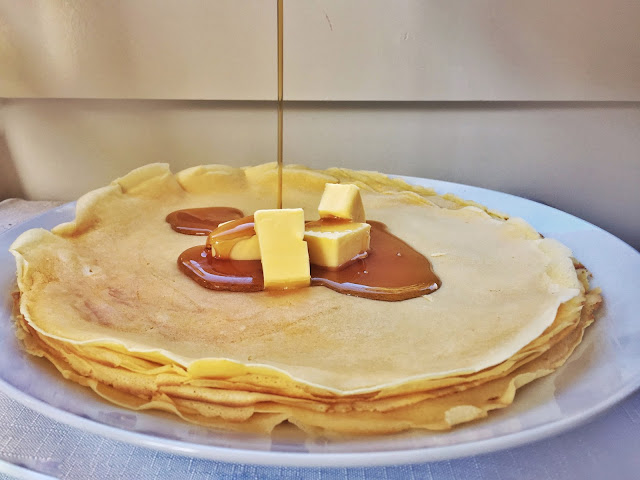You should be making crepes this weekend.

Crepes have a fancy reputation, and it's a common misconception to think crepe-making was reserved for the experts. How could cooking and flipping these thin, delicate pastries ever be easy?
I remember making pancakes as a child, and agonising whether a pancake is cooked all the way through, or still runny on the inside. Because crepes are thin, they are much simpler: when the surface looks dry, the crepe's ready. Easy peasy. The thinner the crepe, the easier it is to judge. (You're bound to tear a few on your first few tries, but stick 'em in the bottom of the stack. No one will suss it, promise.)
Crepe-making really couldn't be simpler. It's a breeze. Easy, I tell you! And you don't need no fancy equipment to make them. If you have a blender (or a immersion blender - and Kmart sells one for $15, which I use), that's great. But with just a whisk and a frying pan, you're good to go. J owns a crepe maker from Kmart but honestly, it complicates crepe-making. It takes a long while to heat up and cook the crepe, and in my hands, the wooden spreader stick keeps tearing the half-cooked crepes. It takes a lot of skill to use, and I'll reach for a good non-stick skillet over the crepe-maker any day. Using a skillet is faster and fool-proof.
 |
| Flipping crepes 101: use a spatula to ease the edge of the crepe off the skillet, then peel it off with your hands. |
Basic Crepes Recipe
Original recipe by J. Kenji López-AltIngredients
2 large eggs
305g/280ml (1 1/4 cups/10 fluid ounces) full cream milk
140g (1 cup/5 ounces) plain flour
1 tablespoon melted unsalted butter/vegetable oil (1/2 ounce; 15ml), and more for coating the frying pan
Pinch of salt
1 tablespoon (8g) sugar (Optional, if making sweet crepes)
1 tablespoon minced fresh herbs (Optional, if making savory crepes)
Steps
1) Combine all ingredients (except herbs, if using) in a blender and process until the mixture becomes smooth, about 10-15 seconds. Add in the herbs and pulse until mixed in.
I have a stick blender and mix the batter in a bowl. Alternatively, a whisk and a bit of elbow grease can bring the batter together too, although I find that if I don't sift, there are always some stubborn clumps of flour remaining.
2) When ready to cook, place a nonstick frying pan over medium heat. Lightly oil the pan and blot out the excess with a kitchen towel. When the pan gets hot enough, using a ladle, scoop out the batter and pour it into the pan, tilting the pan as you pour and making sure the batter is spread out thin and even.
3) Let the batter cook over medium heat until the top is no longer wet, and a finger touching the batter comes away clean (about 20-40s). The edges should curl up and be slightly browned. Using preferably a silicone spatula (or something as malleable), gently pry the edges off the frying pan, and then using your hands, ease the crepe off gently and flip it over. Let the other side cook for 10 seconds, then transfer to a plate.
4) Repeat for the rest of the batter. You may find it useful to turn down the fire between batches - when the pan is less hot, the batter can spread out further before solidifying.
For ideas on filling crepes, the original article on Serious Eats has quite a few ideas.









No comments:
Post a Comment